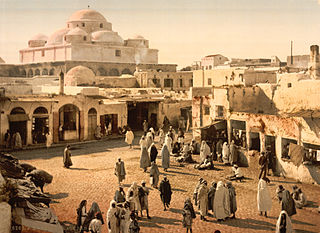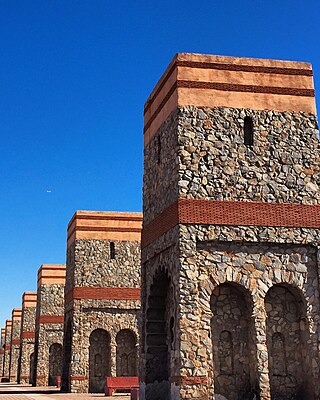
Tunis is the capital and largest city of Tunisia. The greater metropolitan area of Tunis, often referred to as "Grand Tunis", has about 2,700,000 inhabitants. As of 2020, it is the third-largest city in the Maghreb region and the eleventh-largest in the Arab world.

A zawiya or zaouia is a building and institution associated with Sufis in the Islamic world. It can serve a variety of functions such a place of worship, school, monastery and/or mausoleum. In some regions the term is interchangeable with the term khanqah, which serves a similar purpose. In the Maghreb, the term is often used for a place where the founder of a Sufi order or a local saint or holy man lived and was buried. In the Maghreb the word can also be used to refer to the wider tariqa and its membership.

Abū 'Abdullah Muḥammad ibn Sulaymān ibn Abū Bakr al-Jazūli al-Simlālī, often known as Imam al-Jazuli or Sheikh Jazuli, was a Moroccan Sufi Saint. He is best known for compiling the Dala'il al-Khayrat, an extremely popular Muslim prayer book. This book is usually divided into 7 sections for each day of the week. Al-Jazuli is one of the seven saints of Marrakesh and is buried in his mausoleum inside the city.
For the teacher of Ash-Shadhili see Abu Abdallah ibn Harzihim
Abu al-Abbas Ahmad ibn Ja'far al-Khazraji al-Sabti, better known as Sidi Bel Abbas, was a Moroccan Muslim saint. He is the patron saint of Marrakesh in the Islamic tradition and also one of the "Seven Saints" of the city. His festival was founded by al-Hasan al-Yusi at the instigation of Moulay Ismael.

The Medina of Tunis is the medina quarter of Tunis, the capital of Tunisia. It has been a UNESCO World Heritage Site since 1979.

Sidi Mahrez ben Khalaf or Abu Mohamed Mahrez ben Khalaf ben Zayn was a Tunisian Wali, scholar of the Maliki school of jurisprudence and a Qadi. He is considered to be the patron-saint of the city of Tunis.

Lalla (Lella), Řalla or Řadja, is an Amazigh word and title meaning "Lady", "My lady", "Miss." or "Mrs.".

The Sfax medina is the medina quarter of the Tunisian city of Sfax. It was built by Aghlabid prince Abu Abbass Muhammad between 849 and 851. The medina is home to about 113,000 residents, and is dominated by the Great Mosque of Sfax.

The Tourbet el Bey is a Tunisian royal mausoleum in the southwest of the medina of Tunis.

Sidi Bellahssan El Halfaoui Mosque is a Tunisian mosque in the Halfaouine neighborhood in the Medina of Tunis in Tunisia.

AÏsha Al-Manoubya, also known by the honorific Al-Saida ('saint') or Lella, is one of the most famous women in Tunisian history and a prominent figure in Islam. She is "one of the few females to have been granted the title of saint."
Abu Said ibn Khalef ibn Yahia Al-Tamimi Al-Baji, commonly known as Sidi Bou Said was a Tunisian Sufi scholar (wali). A disciple of Abu Madyan, he is mostly remembered for being Abul Hasan ash-Shadhili's teacher during his stay in Tunisia. He likely met with the Andalusian philosopher Ibn Arabi during his pilgrimage and few-years stay in Damascus and Mecca.

Sidi Belhassen Karray mausoleum is one of the mausoleums of the medina of Sfax.

Bou Chouaicha Mosque is one of the oldest and most important mosques of the medina of Sfax.

Sidi Brahim Riahi Mausoleum is one of the most important mausoleums of the medina of Tunis. Founded by Sidi Brahim Riahi.

The Zawiya of Sidi Muhammad Ben Sliman al-Jazuli is an Islamic religious complex (zawiya) in Marrakesh, Morocco. It is centered around the tomb of the 15th-century Muslim scholar and Sufi saint Muhammad al-Jazuli, who is one of the Seven Saints of Marrakesh.

The Zawiya of Sidi Bel Abbes or Zaouia of Sidi Bel-Abbès is an Islamic religious complex (zawiya) in Marrakesh, Morocco. The complex is centered around the mausoleum of Abu al-Abbas as-Sabti, a Sufi teacher who died in 1204. He is the most venerated of the Seven Saints of Marrakesh, generally considered the "patron saint" of the city. The zawiya's architecture dates in part to the late Saadian period but has been modified and restored multiple times since then.

The Seven Saints of Marrakesh or Patron Saints of Marrakesh are seven historical Muslim figures buried in Marrakesh, Morocco. Each of them was a famous Muslim judge, scholar or Sufi saint (wali) venerated for their piety or other mystical attributes. Their tombs form the basis of a centuries-old annual pilgrimage, a ziyara, during which visitors pray at each of their tombs over the course of seven days.





















